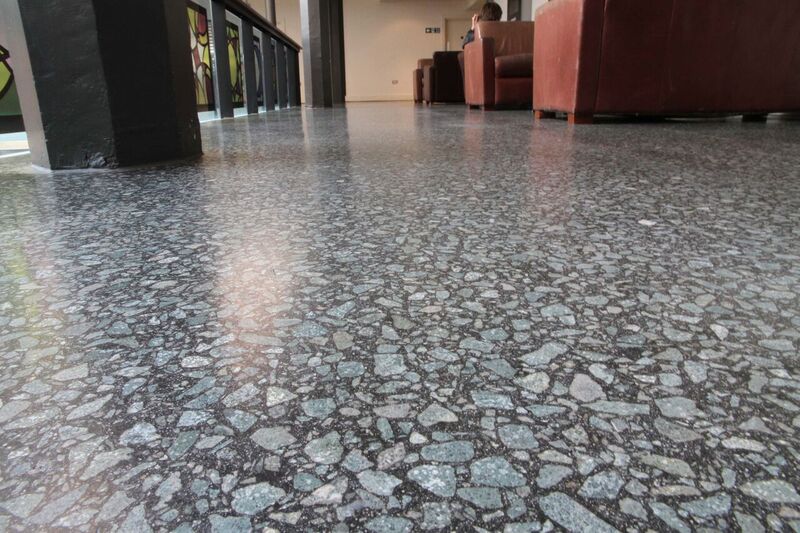Mastic asphalt flooring
Terrazzo mastic asphalt flooring by IKO PLC. Photo credit: Mastic Asphalt Council.
Contents |
[edit] Introduction
The term ‘flooring’ refers to the lower enclosing surface of spaces within buildings. This may be part of the floor structure, such as the upper surface of a concrete slab or floor boards, but typically it is a permanent covering laid over the floor. There are many types of flooring materials available. For more information see Types of flooring.
[edit] Flooring materials
Resilient flooring is loosely defined as flooring manufactured from elastic materials. Products made out of these materials share certain characteristics - they are durable and firm, but they also offer a degree of 'bounce' or resilience. For more information see Resilient flooring.
Mastic asphalt was introduced in the 1900s and became widely used as a type of resilient flooring up until the 1950s. It has experienced an increase in popularity due to useful characteristics inherent in its composition, application and durability.
[edit] Composition
Mastic asphalt is a mixture of fine and coarse limestone and dolomite aggregate and synthetic bitumens. Some grades may also contain natural asphalts, polymer modified bitumens and pigments to create different design effects (such as terrazzo) and colours.
None of the components are classified as hazardous in accordance with the CLP Regulation (EC) no 1272/2008.
Terrazzo mastic asphalt flooring. Photo credit: Mastic Asphalt Council.
[edit] Application
To apply mastic asphalt, the mixture is poured while still hot so it can be distributed evenly. It is then smoothed and left to cool and cure, which takes approximately two to three hours (depending on the temperature in the surrounding environment). This can be an advantage in situations where speed is required.
The thickness of the layer of mastic asphalt can vary, but it typically ranges from 15mm to 50mm, depending on various factors and requirements of the application.
[edit] Durability
While mastic asphalt flooring is not common compared to other types of flooring, it does have advantages in both commercial (in particular industrial, education and healthcare) and domestic applications, especially when water protection is a priority. Due to its water resistant nature, mastic asphalt flooring can be used as a protective layer under carpet, wood and other types of flooring.
In laboratories or manufacturing environments where chemicals and acids (other than solvents) are present and spark resistance is a factor (it has a non-flammable classification of Bfl-s1, under to EN 13501-1) mastic asphalt can also be a suitable flooring option. Warehouses and shop floors that experience regular traffic from equipment such as forklifts and pneumatic trolleys are suitable for mastic flooring.
However, if the surface will have to support heavy, permanent equipment, a mastic asphalt floor may become misshapen from the weight of the load. Therefore, it is important to select Type F1076 mastic asphalt for flooring that is graded according to usage, as follows:
- Grade I - Special hard flooring.
- Grade II - Light duty flooring.
- Grade III - Medium duty flooring.
- Grade IV - Heavy duty flooring.
[edit] Related articles on Designing Buildings Wiki
Featured articles and news
RTPI leader to become new CIOB Chief Executive Officer
Dr Victoria Hills MRTPI, FICE to take over after Caroline Gumble’s departure.
Social and affordable housing, a long term plan for delivery
The “Delivering a Decade of Renewal for Social and Affordable Housing” strategy sets out future path.
A change to adoptive architecture
Effects of global weather warming on architectural detailing, material choice and human interaction.
The proposed publicly owned and backed subsidiary of Homes England, to facilitate new homes.
How big is the problem and what can we do to mitigate the effects?
Overheating guidance and tools for building designers
A number of cool guides to help with the heat.
The UK's Modern Industrial Strategy: A 10 year plan
Previous consultation criticism, current key elements and general support with some persisting reservations.
Building Safety Regulator reforms
New roles, new staff and a new fast track service pave the way for a single construction regulator.
Architectural Technologist CPDs and Communications
CIAT CPD… and how you can do it!
Cooling centres and cool spaces
Managing extreme heat in cities by directing the public to places for heat stress relief and water sources.
Winter gardens: A brief history and warm variations
Extending the season with glass in different forms and terms.
Restoring Great Yarmouth's Winter Gardens
Transforming one of the least sustainable constructions imaginable.
Construction Skills Mission Board launch sector drive
Newly formed government and industry collaboration set strategy for recruiting an additional 100,000 construction workers a year.
New Architects Code comes into effect in September 2025
ARB Architects Code of Conduct and Practice available with ongoing consultation regarding guidance.
Welsh Skills Body (Medr) launches ambitious plan
The new skills body brings together funding and regulation of tertiary education and research for the devolved nation.
Paul Gandy FCIOB announced as next CIOB President
Former Tilbury Douglas CEO takes helm.
UK Infrastructure: A 10 Year Strategy. In brief with reactions
With the National Infrastructure and Service Transformation Authority (NISTA).
























